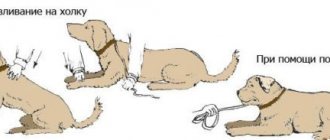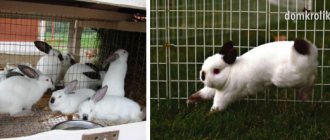Charming Spitz dogs with sly fox faces are smart animals that love to remember commands. Spitz training is an important point in raising an intelligent and obedient pet.
In this article, we will consider the features of proper upbringing, paying attention to the basics of training and typical problems encountered by Pomeranian breeders.
Character traits
For successful training, it is important not only to follow the rules of training, but also to take into account the character traits of your four-legged friend. Proper education of a Spitz is based on its behavior:
- Avoid physical punishment. All animals associate the owner's hands with food, care and protection, so aggression on the part of the owner will result in a cowardly and nervous pet. If your Pomeranian has misbehaved and needs punishment, ignore him. For a loving Spitz, there is no worse punishment, so he will seriously think about his misdeeds.
- Engage in socialization. Spitz are real bullies, so when raising a boy, it is important to explain the norms of behavior in society with other animals and people. With girls the situation is simpler, but still, individuality has not been canceled.
- Don't separate learning from play. Spitz are active and intelligent dogs that love their owner's attention. The educational process will become more interesting if you diversify it with games and season it with obligatory praise.
- Control your loud voice. The Spitz barks always and everywhere, so constant barking tires not only the owner, but also those around him. Timely training of the “quiet” command will eliminate headaches and showdowns with disgruntled neighbors.
- Don’t give in to provocations and show who’s boss in the house. Spitz are incredible manipulators who very subtly grasp the relationship between their own actions and a person’s response behavior. Pomeranians cannot be given even temporary relief.
Difficulties
Manipulation of people, both owners and those who simply pay attention to them, is in the blood of this breed.
Pomeranians are very resourceful and intelligent dogs.
Raising and training dogs should begin from a very early age, otherwise they become real despots in the family. The dogs begin to “rule the show” and demand that all their whims be fulfilled.
This is precisely one of the difficult moments in the character of the breed . Once the owner of the Pomeranian once gives in to the puppy, succumbing to his tricks, his whole life will be subordinated to the hysterics, insults and whims of the dog. Representatives of this breed, regardless of gender, are very sensitive to manifestations of weakness on the part of the owner and members of his family.
On the very first day of arrival in the house, the puppy must learn who is boss in the house . Then you can achieve the development of positive traits in the character of the Pomeranian Spitz - adequate behavior and the correct reaction to the owner’s demands.
Excerpt from the Spitz standard:
The dog is constantly attentive, active and very attached to its owner.
The Spitz is intelligent and extremely easy to train. It is an ideal guard for home and yard. Has good health and longevity.
Types of training
Not all breeders have the opportunity to train a Spitz at home. However, even if you have weak nerves or lack of free time, you cannot leave the situation to chance, because raising a Pomeranian Spitz is organized using one of three types of training:
- canine;
- joint;
- independent.
The existing variability among trainings leaves no chance for excuses, because it is enough to simply choose the appropriate option. Let's look at each of them in more detail.
Canine training
Canine training is reliable and guarantees 100% results. The pet must be sent for temporary training conducted by people with special education. Upon completion, the owner receives an already trained dog.
Dog handlers will be able not only to explain the basic commands, but also to prepare the future winner of exhibition events. The main disadvantages of this type of training:
- paid services;
- forced separation from the Spitz.
Joint
Joint training is the most reliable option, allowing you to learn valuable information about the educational process and get a high-quality result.
The owner undergoes training courses together with the dog in a special obedience school under the guidance of experienced dog handlers. The animal gains invaluable experience of communicating with other dogs and is not taken away from a loved one.
Independent
For those who do not want to shell out extra money and do not trust strangers, the option of self-training is suitable. This option requires complete dedication and long-term study of specialized literature, but is more than compensated by the strong relationship gained when interacting with the pet during the educational process.
How to choose a puppy
You should purchase a puppy only from a reliable nursery, which will provide all documents not only for the offspring, but also for the parents. The puppy should be active, with no discharge from the nose or eyes, or signs of diarrhea. The presence of fleas or worms is unacceptable. An excessively bloated abdomen indicates problems with the intestines. It is not advisable to choose the smallest puppy from the litter, as it will be weaker than the rest.
Where and when to start training?
You shouldn’t delay training your Pomeranian Spitz. You can and should teach your pet simple basic commands from the age of 1.5-2 months. The earlier training begins, the greater the chances of getting an intelligent and obedient pet. A young age is a big plus in the educational process, guaranteeing the absence of established bad habits.
At the initial stages of training it is important:
- Maintain regularity. Do not take breaks, because even a small relaxation can slow down the entire process.
- Repeat the material covered. Don't rush with new commands, but make sure to consolidate the old ones.
- Be patient. A little Pomeranian has the right to make mistakes in his first lessons.
- Properly alternate between praise and punishment. No learning is complete without carrots and sticks, but it is important to do it right. Praise your child for any, even the smallest, successes and show dissatisfaction with mistakes.
- Protect the client from distractions. When training outside, try to find an empty area. Foreign animals should not distract the aggressive Spitz.
Necessary conditions and rules
When training a Spitz, it is important for teams to follow the following rules:
- Win the love of your four-legged friend . Pomeranians are kind to their owners, so they strive to do everything possible to please them.
- Try to get rid of the negative aspects of this breed. Learn to control barking, aggression towards other animals and self-will.
- Don't try to jump over your head. Do not require your puppy to memorize complex commands and do not put too much pressure on him. Maintain a smooth transition from simple skills to more complex ones. Remember that you need to start training from the very basics.
- Use different intonations when teaching voice commands. Remember that in most cases a calm voice is used, and a strict one is used only when there are prohibitions (“fu”, “impossible”).
- Never change your usual names. Each command is accompanied by its own name, and even the slightest change in the ending of the word will cause difficulties for the pet.
- Don't let your Pomeranian follow commands given by other people. Otherwise, there is a risk of the Spitz being stolen, because the dog will trustingly run to any outside call.
- Combine verbal and nonverbal cues . In addition to the voice command, try to teach your pet to understand certain gestures by coming up with its own designation for each action.
Basic commands
A trained Spitz is distinguished by unquestioning obedience, earning the respect of others and the pride of the owner. If intricate tricks are included in additional skills and abilities, then you cannot do without basic commands:
- Nickname. Memorizing your own name is a good first practice. Simplicity is important for dog names, so save fancy names for passports. Call your Spitz by name from the first time you meet him, when he first appears in your home, and reward his response with treats and affectionate words. A savvy Pomeranian will quickly make the connection.
- Ugh. The main word in training that means danger. Use it when your Spitz is trying to eat something suspicious, accompanied by a firm pull on the leash and a stern intonation. Remembering this word will help protect your pet from unwanted poisoning, so it needs to be understood as early as possible.
- It is forbidden. It is also pronounced in a clear and firm voice that does not accept objections, but has a different purpose. The command is used to immediately stop unwanted behavior: begging, bullying other dogs, loud barking and other actions that should not be done without appropriate permission.
- Place. Give your spitz a personal corner and explain its purpose. After saying the command, take him to his place and praise him. This will allow you to calm down the dog that is disturbing the guests, but will not cause negative emotions.
- To me. Pets scurrying between the legs of passers-by and bullying other animals do not evoke pleasant emotions. Say the right words and gently pull the leash. When the dog responds, you need to praise it. Unlike “fu,” this phrase does not convey information about a threat, but also requires a quick reaction.
- Sit. An important transition point in training between heavier teams, allowing for the development of discipline. Place the dog at your side, holding it on a short leash, say its name and the necessary command. Next, gently press on the sacrum, pulling the leash in the opposite direction and up. If successfully completed, do not forget about praise and encouragement.
- Near. Rescue team used in crowded places. After saying the command word, gently pull the leash, moving the animal to the left leg. Whenever you try to speed up or change direction, repeat the correct word and tighten the leash again. Remember that pulling should not be painful and an obedient Pomeranian should be rewarded.
More complex commands, such as “fetch”, “voice”, “wait” and others, are added at six months of age, when the pet already has a basic set of knowledge.
Other useful skills
Commands are only a small part of what needs to be taught to a Spitz. It’s impossible to cover all the skills in one article, but there are key skills that you can’t do without.
Nickname
The first thing a kitten should remember in a new family is its name. It's easy: just repeat the name as often as possible, and after 3-5 days the Spitz will learn it.
It is important that when pronouncing the nickname, the puppy breaks away from his work, turns his head towards the owner and looks into the eyes for a couple of seconds.
Toilet
Until the puppy has learned to tolerate and relieve himself outside, he is taught to go to the toilet in a certain place in the house. The skill will also come in handy for adult German Spitz dogs - they won’t have to wait hours before going for a walk, and in inclement weather they can skip the walk altogether.
For this:
- lay out a dozen moisture-absorbing diapers around the apartment;
- as soon as the kitten spins in one place and sits down, they take him to the nearest toilet, wait until the baby copes, and praise him;
- day by day the number of diapers is reduced until there is only one left;
- after 1-2 weeks it is transferred to a tray;
- Gradually the diaper in the tray is cut off until a small flap remains - and then they throw it away too.
Dogs are not cats. While whiskers learn to go to the litter box in a couple of days at most, Spitz dogs learn this skill in weeks.
Avoid excessive barking
German Spitz are more talkative than a parrot. They bark shrilly and loudly at the slightest provocation. The order “Quiet” will help calm down the flow of words. But it doesn't always work.
You can show that you don’t like yapping:
- leaving the Pomeranian alone;
- stopping barking and scolding the dog at the first yelp;
- distracting your pet with toys and treats;
- sending the pet to its place.
Uncontrollable barking is a sign of anxiety. It will help to exclude him from being examined by a veterinarian for possible diseases, going for a long walk, and solving psychological disorders.
The ability to be alone
German Spitz are very attached to their family, it is difficult for them to stay at home alone. Therefore, when the owners leave, they worry, bark, howl, and spoil things.
In order for the pet to easily tolerate loneliness, it is taught to be alone from puppyhood:
- lock the dog in a separate room;
- as soon as he gets worried, they order “No”;
- if it follows people, they calmly, silently return them to their place.
Such demonstrative abandonment is practiced every day, constantly increasing the time without owners. If a Spitz sits quietly for half an hour, it will withstand many hours of separation.
Socialization
It is impossible to raise a Spitz without socialization. In the family circle, a dog can be three times charming, but if he does not know how to normally relate to strangers, animals, and sudden events, no amount of training will help.
Spitz socialization begins at 3-4 months, when the vaccination quarantine ends. The dog is introduced to:
- children;
- other people's pets;
- unknown adults;
- travel by personal and public transport;
- noisy places;
- veterinary clinics and other institutions that you will have to visit frequently.
When they go out for the first time, they take treats with them. They are fed periodically - this way the dog will not worry and will focus on the owner. It is important to ensure that the Spitz reacts to surrounding people, animals and unfamiliar places without fear or aggression.
How to stop a Spitz from barking?
Barking is the main disadvantage of charming Spitz dogs. It is important to teach your Pomeranian to control the volume of his voice from an early age.
Try to identify the cause of the barking . A pet can yap for completely different reasons, expressing:
- joy;
- aggression;
- fear and much more.
Distract your Pomeranian's attention during any attempts to bark uncontrollably by:
- toys;
- muzzle;
- water splashes.
Follow these tips:
- Resort to ignoring, showing displeasure with unpleasant sounds.
- Scold, but do not use corporal punishment . Explain to your Pomeranian that barking should never be used in vain. Convey the command “voice” to the Spitz, showing that barking indicates danger.
- Walk your Spitz for at least 1.5 hours. A splash of energy will calm the orange and moderate his ardor.
- As adults, use the commands “no” and “place”. A smart dog will quickly understand the relationship and try to eliminate unacceptable actions.
- Do not forget to praise for the correct execution of the command. A satisfied owner is the best incentive, and a tasty treat is an additional motivating factor.
Appearance of a Pomeranian Spitz
The Spitz dog breed, especially the orange one, is distinguished by its attractiveness. They simultaneously resemble a fluffy toy and northern dogs (especially the eyes and ears, as well as the tail thrown over the back). The main characteristics of the Pomeranian's exterior, as defined by the breed standard, are given below.
- Head. Has a medium size. The forehead is wide and round. The transition from forehead to nose is clearly defined. The nose is much shorter than the frontal part, not pointed.
- Mouth. The lips are dry, closed, painted black. The teeth are small. Their set is complete. Scissor bite.
- Ears. Standing. They have a triangular shape. Landing is close.
- Eyes. Medium in size, slightly slanted, giving the dog a slightly cunning appearance. The look is always lively and interested. The color of the iris is brown - from dark to amber.
- Body. Compact, proportionally folded. The back is straight, turning into a short croup. The chest is deep and wide. The neck is of medium length, appearing quite short due to the abundance of fluff and fur.
- Paws. Straight, parallel, with a fairly wide arrangement. Provides the dog with good stability. The hock joints of the hind legs are strongly developed, giving a springy gait. The foot is rounded. Fingers fit tightly together
- Tail. Middle length. Set high and, like northern dogs, lies on the back.
Regardless of the color of the orange and the type to which it belongs, the main characteristics of its appearance will be the same.
Significant deviations from them are grounds for lowering show scores or even preventing the dog from participating in shows. If there are serious defects in the exterior, it is highly recommended not to let the animal go into breeding.
How to teach to go potty?
Puppies raised in a kennel are already toilet trained, but in a new place you will still have to work a little:
- To avoid damage to carpets and rugs, remove unnecessary elements during training, because the small size of the breed will not greatly brighten up the scale of the “wet tragedy”.
- Buy a set of disposable diapers. When trying to relieve yourself, try to have time to transfer the Spitz to the prepared diaper and praise if successful. Any training is based on iron patience.
- Do not scold or punish the Pomeranian in case of failures. New smells frighten the puppy and require adaptation to understand the new latrine.
- After the puppy gets used to the diaper, you can put the tray in its usual place. For better results, place a wet diaper there so that the Spitz associates the new object with the action expected from it.
- Each time, move the tray closer and closer to the toilet until it is in the right place.
Strict adherence to these steps will allow you to toilet train your Pomeranian Spitz even in puppyhood without any problems.
Tips from dog handlers
If you choose independent training, dog trainers recommend adhering to the following tips:
- Consider the dog's character. All animals are unique and each of them requires a special training program, adjusted to a specific character.
- Seek professional help if you have difficulties. Don't be afraid to communicate with kennel club staff. They will definitely help in solving any problems, because this is what their main work is based on.
- Never make exceptions and avoid provocations. One mistake and the Spitz, feeling like a full-fledged authority, will begin to twist the rope out of the owner.
- Don't forget the importance of walking. Long walks are the key to keeping the little Energizer calm.
Once you become the owner of a little bundle of happiness, try to follow these recommendations. Remember that the specifics of training depend entirely on the character of the particular animal. You can’t put all dogs under the same brush, because they are all unique.
Training your pet on your own has the right to life and allows you to achieve maximum mutual understanding with your four-legged friend. Do your best and raise a pet that you can be truly proud of.
How much does a Pomeranian cost?
The cost of a dog depends on its conformity to the exterior. You can buy a culling at a nursery for 18-30 thousand rubles. depending on color. Since there are from 1 to 3 puppies in a litter, even culling is expensive. If a promising Spitz is selected, which is distinguished by show qualities, it can cost 150-170 thousand rubles.
The Pomeranian Spitz is a wonderful pet for those who love active walks. When you start one, you can be sure that a fluffy bundle of energy and happiness will appear in the house, sincerely loving all family members.











